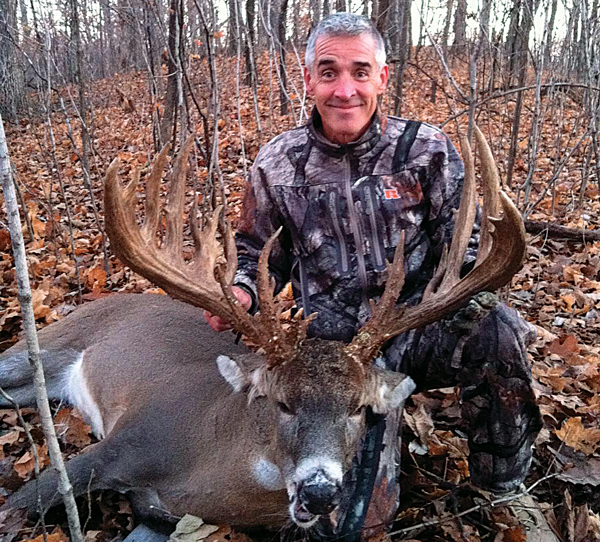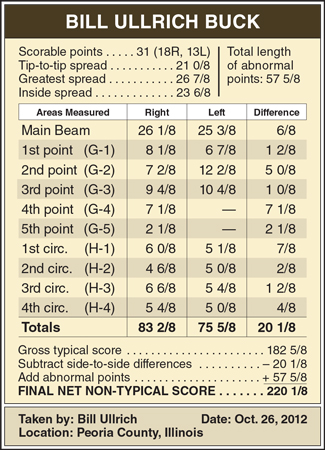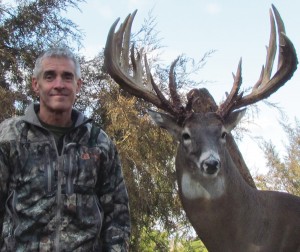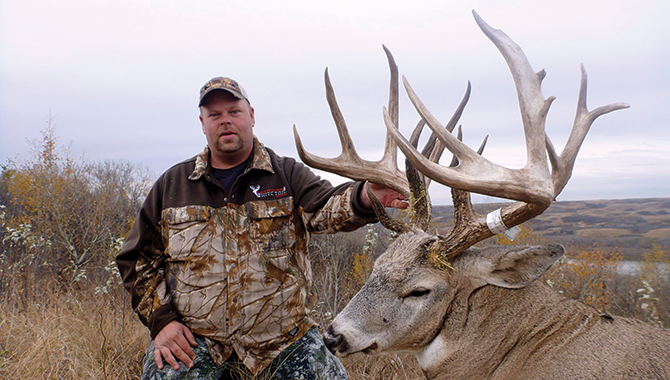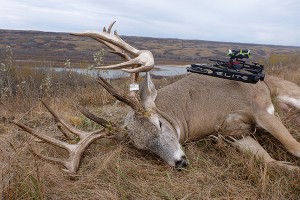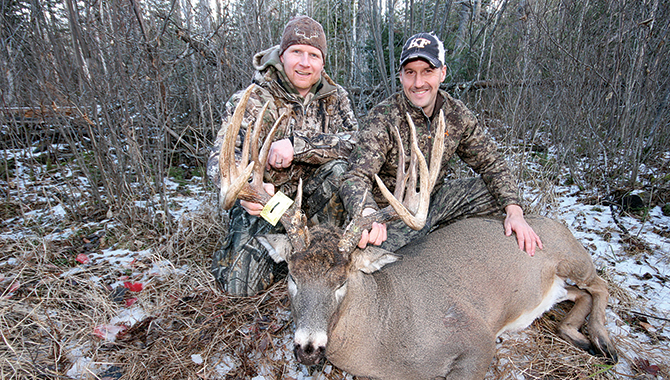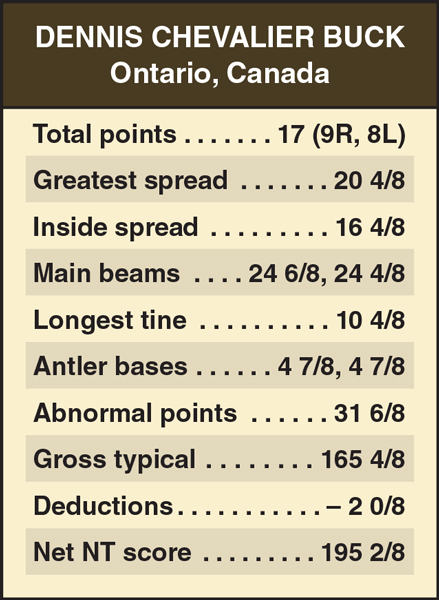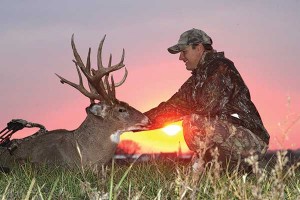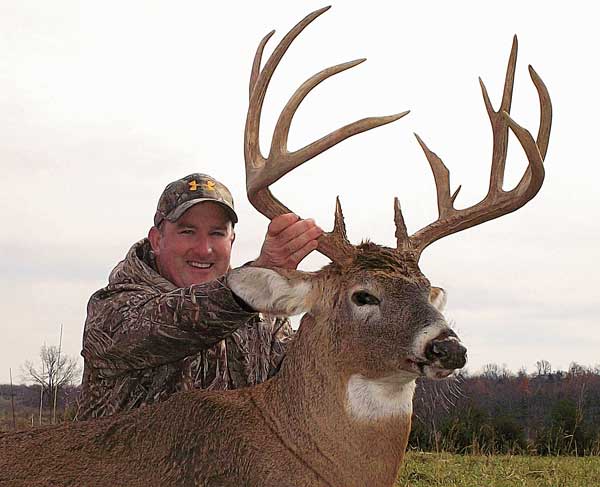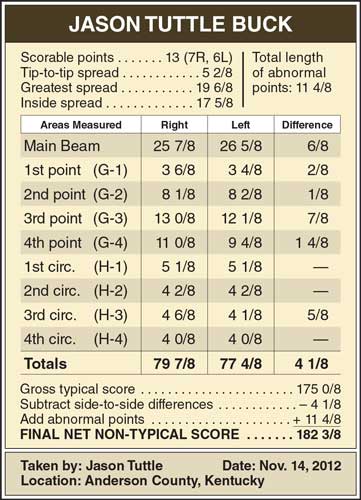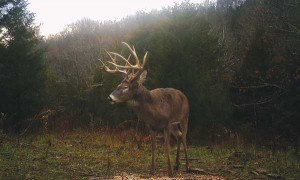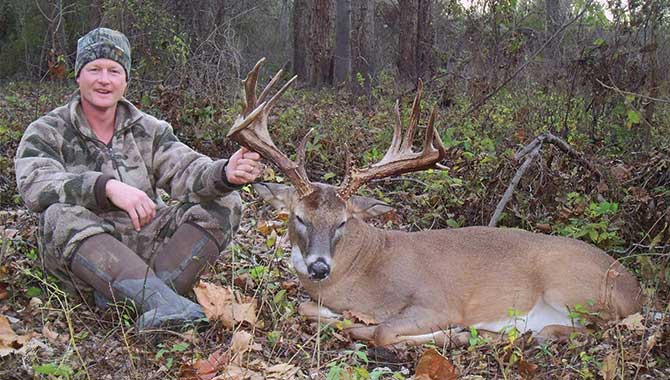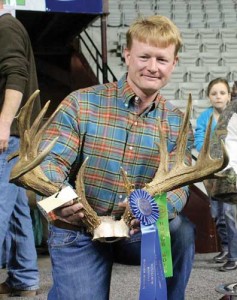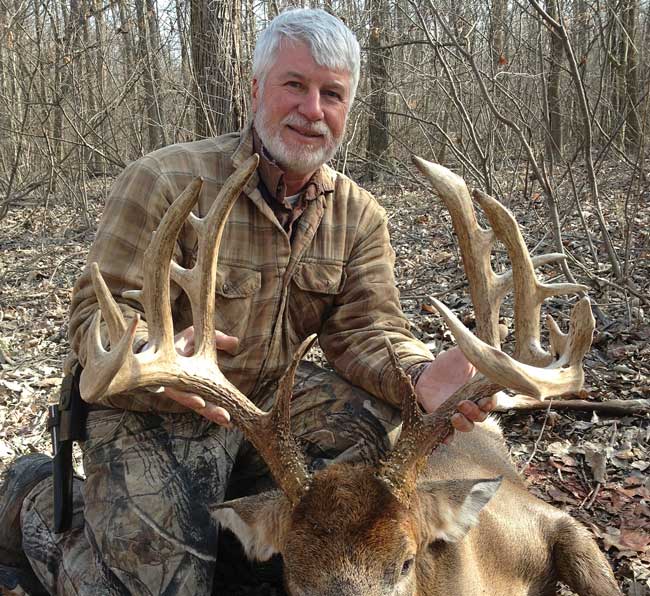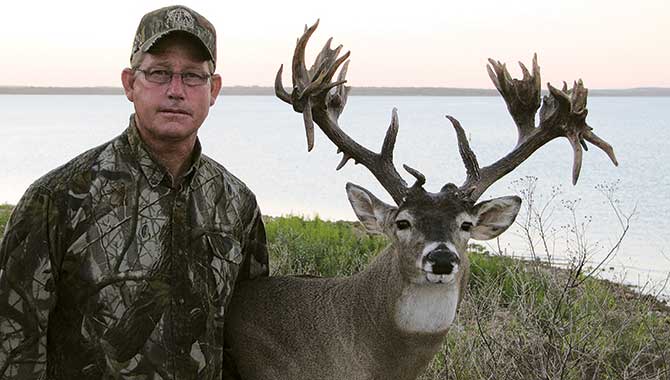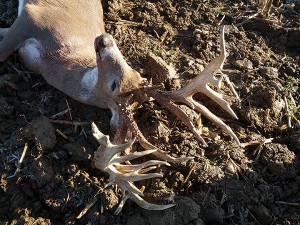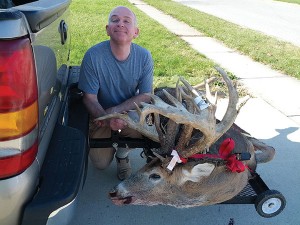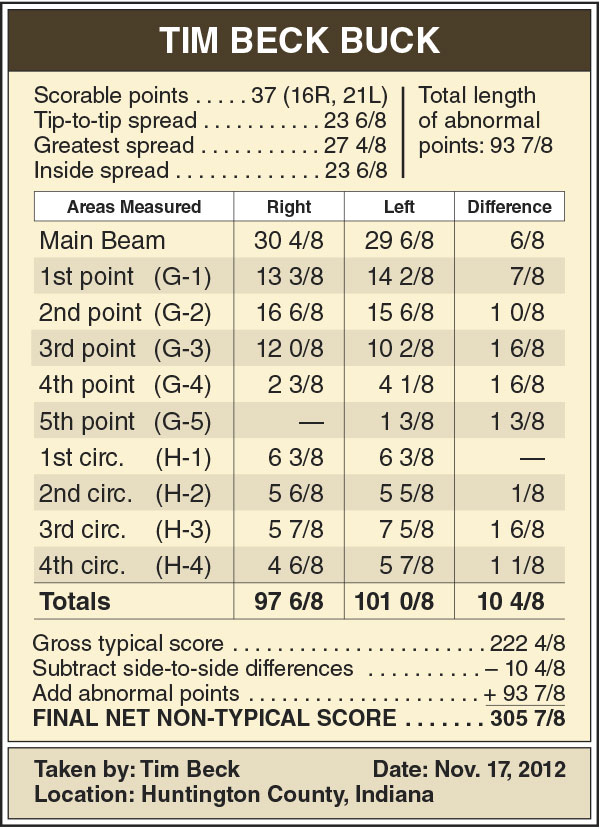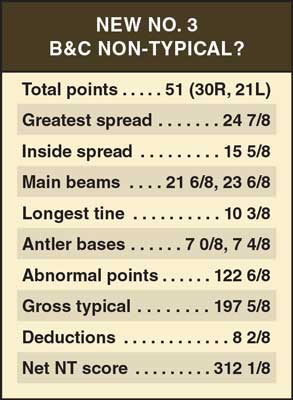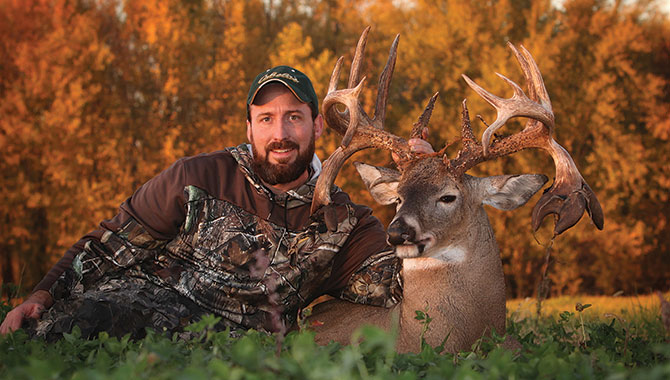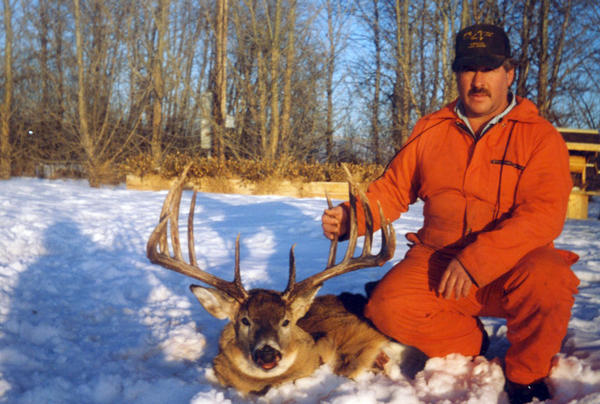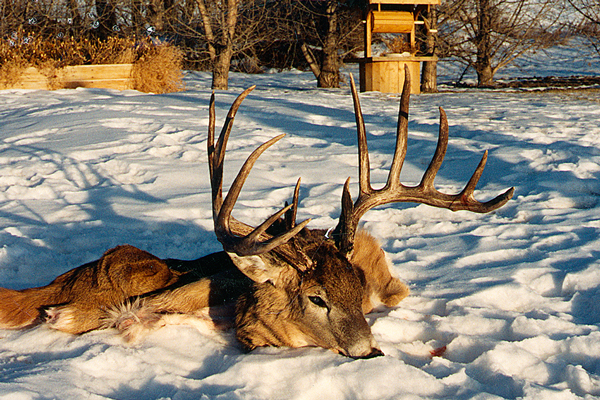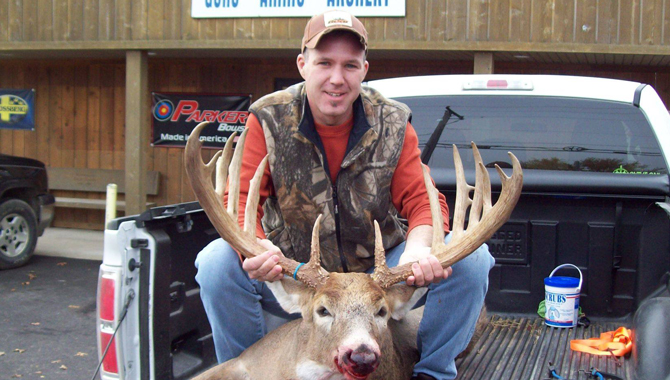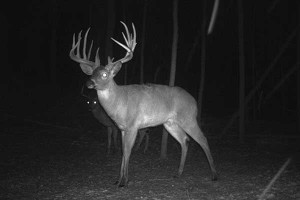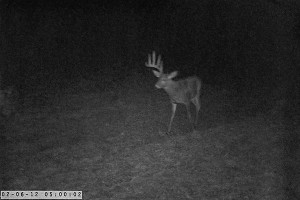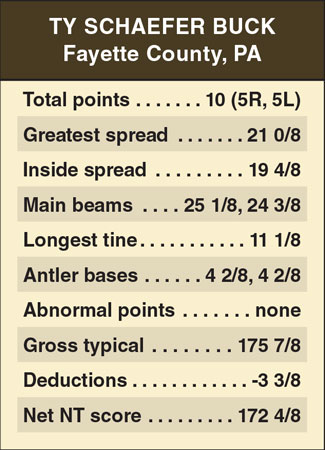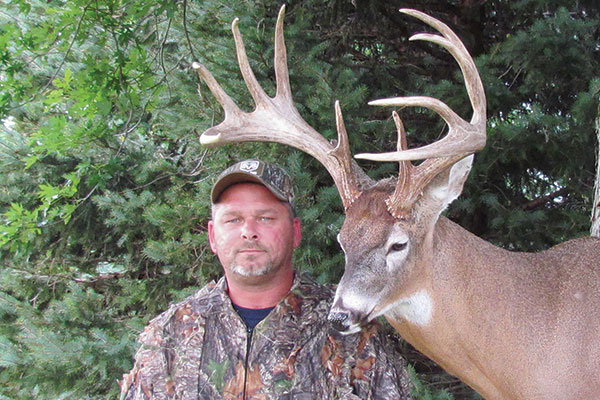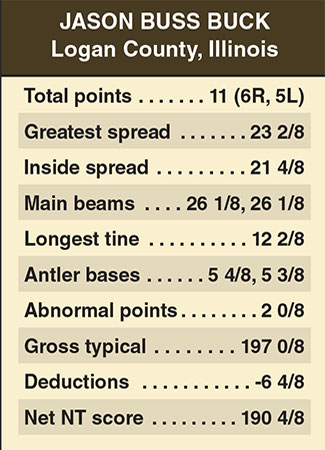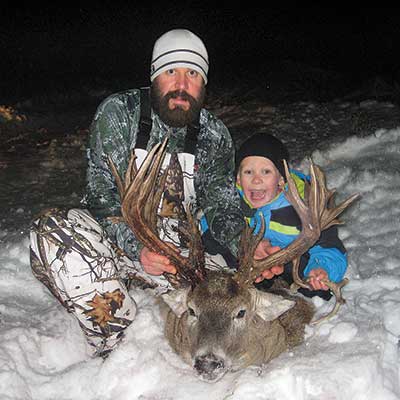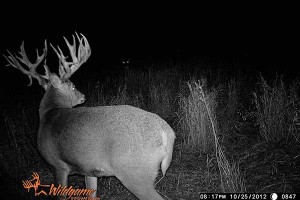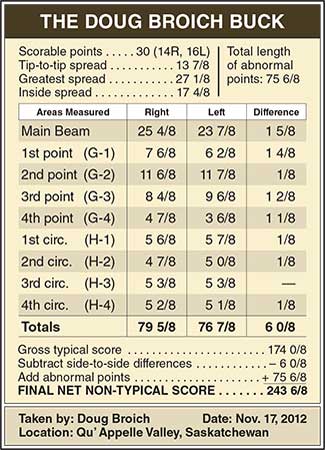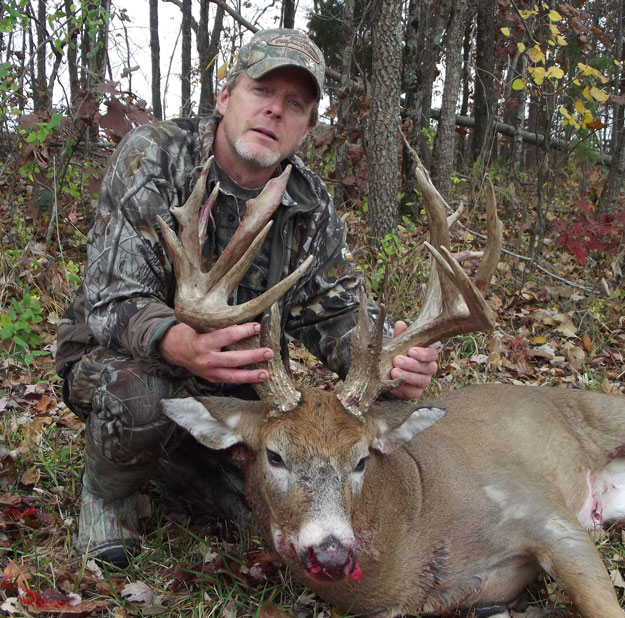![Jim Cogar Buck: 213-Inch Buckeye Beast]() Despite one of the worst droughts in history, in July 2012 my expectations for deer season here in central Ohio were as high as ever. Trail cameras were set, mineral sites were established, and other attractants were strategically placed throughout the farm. But after monitoring trail cameras for two months, I realized our inventory of big bucks was depressingly low. Although bow season was right around the corner, a “hit list” had yet to be established.
Despite one of the worst droughts in history, in July 2012 my expectations for deer season here in central Ohio were as high as ever. Trail cameras were set, mineral sites were established, and other attractants were strategically placed throughout the farm. But after monitoring trail cameras for two months, I realized our inventory of big bucks was depressingly low. Although bow season was right around the corner, a “hit list” had yet to be established.
What made this disconcerting was the fact we’d taken no bucks off the farm the previous year. My core hunting group (which includes my father, Philip “Jim” Cogar, and brother-in-law Rob Donahue) had let the buck population rebuild in 2011-12. All three of us, as well as Invite X-tream and Doc’s pro staffer Chase Adams (who also hunted the farm) chose to pursue our bucks elsewhere. Surely, we felt, our collective commitment that season would pay off in the future.
REAPING BENEFITS
Despite the lack of mature bucks on our cameras in late summer, by last Oct. 22 our “hit list” had grown to four. And by Nov. 7, three of those four deer were at the taxidermy shop. My father, Rob and Chase all had managed to get it done, stretching the tape to nearly 450 inches of antler among them. Interestingly, each of those bucks was 20-30 inches larger than he’d been the year before!
Clearly, the previous season’s sacrifice by everyone had paid tremendous dividends after all Regardless of how the rest of the 2012-13 season went, I already considered it to be a huge success. As I was to learn, it was far from over.
SAVING THE BEST FOR LAST
Let’s rewind back to Oct. 27. I was eagerly anticipating some bowhunting after spending the earlier part of the month scurrying around with out-of-town weddings, birthday parties and road trips back home to Canfield, Ohio. After the morning hunt, I was anxious to go through photos on the memory card I’d pulled before leaving the woods. That’s when I saw him for the first time.
“Un-be-lievable!” was all I could manage to say as the image popped up on the computer.
“What? What?” Dad asked anxiously. He couldn’t see the screen from where he sat.
“Dad, not only do we have a ‘Booner’ on our hands, we have ourselves a 200-incher!”
Needless to say our plan to take an afternoon nap before heading back out for the evening hunt was quickly canceled. Instead, the next few hours were spent staring at two photos of this new giant and talking strategy.
Rob, our friend Chris Sharp (board member and Ohio hunt manager for the non-profit organization Physically Challenged Bowhunters of America) and I always assign nicknames to the bucks we pursue. However, in this case my dad was the one who came up with the name. Without hesitation, he uttered the word “Conan.”
I asked him to repeat himself, and he said, “That’s what we’re going to call him: Conan!” Of course, this was a reference to Arnold Schwarzenegger’s character in the 1980s movie, Conan the Barbarian. And it seemed a perfect name for this giant.
With the rut and our annual week- long hunting camp quickly approaching, a plan was devised to bag this truly once-in-a-lifetime deer. But the excitement was short-lived; our week of vacation passed with no sightings and no further trail camera pictures of Conan. Then, as quickly as the rut had come and gone, so too had nearly all of November.
By now, doubt and frustration were setting in. More than a month had passed since our last picture of the giant. With two more months of archery season and in my opinion some of the best hunting still left to go, I regrouped and started thinking late-season tactics.
Although a second round of out-of-town travel kept this weekend warrior sidelined for a while, I was constantly thinking about my next move. Years of experience with coming across big bucks on trail cameras, only to have them disappear forever, were all too familiar to me. This time I was determined not to let it happen.
Two weeks before Christmas, I had one day to sneak out to the woods. The plan was not to hunt the same old stand sites. As a matter of fact, I wasn’t going to hunt at all. My objective was to reevaluate the property and scout it all over again, looking for late-season deer activity. Having three cameras, I decided to set them up in the top three spots I could find, based on my most recent information.
A week later I checked the cameras, and wouldn’t you know it? Conan had made a cameo on Dec. 18, after a nearly two-month hiatus.
ROUND 2
Proof that he was still alive was the motivation I needed to press on through the late season and hunt harder than ever before. I was determined to will this deer into bow range before season’s end. The law of attraction (the theory that one can control achieving goals through positive thinking) was in full effect.
![]() Aside from telling a select few other hunters, as well as my taxidermist (Zoran Saveski of Highpoint Taxidermy in Thornville), I kept Conan a secret. This was difficult, as it’s my nature to share my trail camera pictures with my hunting buddies. But I knew that practice had historically been my kiss of death. In almost every instance, any record-book buck I’d shared pictures of had ended up being taken by someone else. Always the outfitter and never the hunter, as they say!
Aside from telling a select few other hunters, as well as my taxidermist (Zoran Saveski of Highpoint Taxidermy in Thornville), I kept Conan a secret. This was difficult, as it’s my nature to share my trail camera pictures with my hunting buddies. But I knew that practice had historically been my kiss of death. In almost every instance, any record-book buck I’d shared pictures of had ended up being taken by someone else. Always the outfitter and never the hunter, as they say!
A phone call in January from good friend Mike Aleshire, who farms and hunts the land north of me, yielded season-changing information. He told me about this tremendous buck his trail cameras had managed to get a few pictures of. Always up for some big-buck photos, I stopped by his place one day after work. To my dismay, I discovered that his new visitor was in fact Conan.
Normally, I’d have been extremely excited, exchanging high fives with my friend. Knowing me well enough to recognize that I was acting a bit strange, he looked at me, grinned and said “OK, out with it.”
I smirked back and said, “Well, I guess my secret is out.”
By now, friends Frank and Joe Aleshire also were pursuing the buck — 1.5 miles from where he was frequenting my trail cameras. To say I was perplexed would be an understatement. What was a deer of that caliber doing traveling so far every few days in mid-January?
Everything I’d ever read talks about how big bucks during that time of year, long worn out by the rut and battling harsh winter conditions, go into energy-conservation mode. Typical behavior at that time should consist of bedding all day, only to get up once or twice for a stretch or to grab a quick bite. Conan clearly wasn’t holding to that pattern.
And continuing his non-traditional ways, the deer started to make daytime appearances in front of the camera — but only on Mike’s farm. With below-average temperatures and the above-average snowfall we were experiencing, my buddies were able to pattern him down to one of two stand sites.
Then, on the evening of Jan. 18, I received a phone call that Frank had actually managed to shoot Conan and that my friends were still tracking him. They tracked him that night and the next day, but to no avail.
Dreadful thoughts now consumed me. Had this traumatic experience left Conan educated enough to become fully nocturnal and even more reclusive? Worse yet, had he buried himself somewhere in thick brush and died?
Thankfully, my fears soon were set to rest. Five days later, on Jan. 23, guess who decided to show back up on my trail camera? It was Conan, sporting a noticeable back wound where Frank’s arrow had entered.
ROUND 3
Sunday, Feb. 3, was the last day of Ohio’s archery season. It also was Super Bowl Sunday. Having played college football at the University of Findlay, I’m a huge fan of the game. However, while the rest of America was anticipating the Ravens-49ers battle, I was gearing up for my own final showdown, perched on a cold metal platform high in a tree.
This particular stand was not my typical setup. Usually I’m 30 feet high in a hang-on stand. As this site wasn’t conducive to such heights, I was preparing to hunt from a trusty 15-foot ladder stand.
NOW OR NEVER
Shortly after getting hugs and kisses from my wife Summer, daughter Kensie and son Cru, I was en route to the final hunt of the season. For never having actually laid eyes on this deer, I felt incredibly confident that this hunt would be unforgettable. The feeling was bolstered when I got an uncharacteristic “good luck” call from my mother-in-law just minutes before I took my stand. Being caught slightly off-guard by her call, I laughed and jokingly thought, OK, that was a sign. Now it’s on!
Once I’d settled into my stand, it wasn’t long before deer were up and moving. A chilly 20 degrees and snow flurries made for great movement. However, the swirling northwest winds were proving troublesome down in that creek bottom. Every deer I encountered was extremely jumpy and kept running off, only to very hesitantly come back in. I was glad I’d washed my clothes one last time, in addition to taking my standard scent-free shower.
And then, as I analyzed my strategy, scent-free shower and all, I looked to the top of the hill. And there he stood! It was such a surreal moment, witnessing for the first time the very deer that had consumed my thoughts daily since October. Despite losing an estimated 50 pounds from the time I’d first seen him on camera, Conan was by far the most amazing creature I’d ever laid eyes on!
Unlike all of the other deer, he appeared unaffected by the wind; he came trotting down the hill on a string right toward me. But as I slowly stood to get ready for a shot, out of nowhere a yearling buck appeared — and he situated himself perfectly between Conan and me.
Conan hit the brakes and proceeded to watch the young buck, which was playing that head-bobbing game with me, trying to get me to move. Moments later he spooked and ran off, taking Conan with him.
Initially my heart sank as I watched the most majestic animal I’d ever seen running away. However, at the time I couldn’t help feeling anything other than eternally grateful—grateful just to have had the opportunity to see such an animal. His running off wasn’t about to dampen my excitement. With a fair of amount time left before dark, I still felt he’d show himself again.
The young buck hadn’t liked something about my setup. It then occurred to me that I’d never stood while hunting that stand. I immediately sat back down and swung my legs to the side, letting them dangle to the right of the seat. This would allow me to come to full draw much more easily from a seated position.
About an hour later, I caught movement atop the hill and saw three bucks moving very slowly in my direction. The last in succession was Conan!
What usually takes seconds for the deer to work their way down to me took them minutes, due to the windy conditions and their jumpy disposition. Bow in hand, release on and with feet dangling off to the side, I was ready. There were now just 30 minutes remaining in Ohio’s bow season.
The final showdown was on, and in typical big-buck fashion, Conan took a different route than the other bucks. Twice he worked his way within 25 yards, yet neither time was there even the slightest chance for a high-percentage shot. Conan then spooked and ran off one more time. This time I came to full draw and had a 45-yard shot but elected not to take it.
![]() The giant continued to work his way out to 80 yards — then, all of a sudden, he stopped and looked back down the hill. There stood the very same yearling buck that had caused him to run off earlier that evening. Conan’s body language suggested he wasn’t happy about the subordinate buck not following his lead. The huge deer worked his way back downhill toward me, ears pinned back, walking with a purpose.
The giant continued to work his way out to 80 yards — then, all of a sudden, he stopped and looked back down the hill. There stood the very same yearling buck that had caused him to run off earlier that evening. Conan’s body language suggested he wasn’t happy about the subordinate buck not following his lead. The huge deer worked his way back downhill toward me, ears pinned back, walking with a purpose.
Eventually Conan took the place of the young buck next to a tree I’d ranged 100 times before at 25 yards. Then something to the east diverted his attention, distracting him long enough for me to come to full draw again. Several seconds later he went on to take two more steps, giving me a slightly quartering-to angle. I gently squeezed off the release, sending my arrow on its way.
I couldn’t see where the arrow entered, but the sound at impact alone was enough for me to know it was in the deer’s vitals. Conan ran to the top of the hill, tail tucked, and then stopped for about 30 seconds. I must have set a world record for the most times repeating the words “Go down” within a 30-second time frame. After watching him fall, I immediately hung up my bow, leaned back against the tree, and started to give thanks.
A phone call to my father was now in order. As soon as I looked at my phone I took note of what time it was and realized that only 20 minutes remained before the Ohio archery season would officially conclude!
Barely able to speak, I gave Dad the great news. He excitingly yelled, “You got him!?” That was followed immediately by, “Jimmy got him!” as he shouted to everyone who had gathered at my parents’ home for a Super Bowl party. I could hear everyone in the background erupt in celebration, and that’s when I lost it. Having a short cry never felt so good!
Even though I’d seen Conan fall a mere 75 yards away, I still quietly backed out of the woods and called for reinforcements. As soon as my friends Mike Little and Shane Bivens showed up, I jumped into Shane’s truck. Shaking from both the cold and adrenaline, I excitedly retold the story of my hunt of a lifetime.
Within an hour, I had eight friends and both landowners present for the recovery effort. With no tracking job needed, we walked right up to the deer. Instead of the normal celebrating, we just stood there in silence, marveling at the majestic monarch that lay before us.
Once I had my temporary tag on Conan, concern that one or both antlers might pop off consumed my mind. (Some bucks in Ohio start shedding in January, if not earlier.) I knew we shouldn’t pull him out by his rack, so Shane came up with the idea of taking apart my 15-foot ladder stand and using one of the 5-foot sections as a “stretcher.” It worked!
Not thinking clearly that evening, I forgot to grab my trail camera or the arrow, which was still sticking into the ground. A few days later I returned to pick up everything. Checking my memory card, I saw my Cuddeback had managed to capture two images of Conan that day. One was taken two minutes before I shot him, the other a fraction of a second after the arrow passed through him. Barely visible in that photo was the arrow sticking in the ground as a blurry Conan ran off.
SCORING CONAN
Sixty-plus days later, the rack was officially measured by Steve Boham and Dave Orndorf, who as a team represented Boone & Crockett, Pope & Young and Buckeye Big Buck Club. Buckmasters Trophy Records master scorer Ed Waite Jr. measured the rack for that organization.
There were two very different interpretations of the antlers. As a result, while Conan now ranks as P&Y’s No. 9 Ohio non-typical, with a net score of 213 4/8, he ties for the typical world record for compound bow kills in BTR.
The folks at P&Y also informed me that this was their first-ever Ohio entry to have been shot in February. In fact, after some additional research and record book clarifications, it appears my buck is the largest wild whitetail ever taken anywhere in February, by any means!
Wanting to know as much as possible about the deer, I made arrangements to find out his age. A forensic tooth-aging analysis performed by Wildlife Analytical Labs of Burnet, Texas, confirmed Conan, aka “Mr. February,” was 7 1/2 years old.
I’d be remiss if I didn’t give a special, anonymous “thank you” to both landowners. You know who you are. And finally, I’d like to thank Dustin Miller of Sunbury, Ohio, for providing me with such amazing trophy photos after the hunt.
×
Aaron Joliff
As a winter front pushed through northwest Arkansas on Dec. 12, 2011, the gray and ominous clouds hung low in the winter sky, drizzling rain. Days like this are exactly what Aaron Jolliff, of Bella Vista, Arkansas, has always loved to hunt—and for good reason. So began Joliff's 2011 hunt, which ended with a lifetime 170-inch buck. Read more at NAW's Deer of the Day.
Aaron Milliken
Aaron Milliken caught up with this massive Kansas whitetail after repeated attempts to track down the 194-inch trophy. For the details, make sure to check out NAW's Deer of the Day entry..
Barry Turner
After an off-season spent drooling over trail cam pics of the deer he'd come to know as "Big Show," Barry Turner came face to face with a Missouri giant. The rest of his story—and his 217-inch trophy—are enshrined in NAW's Deer of the Day.
Bill Winke
Bill Winke has earned himself a spot as one of the best Midwestern whitetail hunters of all time, with a recent buck to prove it. To read more about this massive double G4 Iowa giant, check out NAW's Deer of the Day entry.
Bo Cocannouer
Two years ago Bo Cocannouer fell from a treestand fracturing his back. Most hunters aren’t lucky enough to walk away from a twenty-foot fall, and the ones that do don’t normally get to hunt from one ever again. But Cocannouer did just that, and he came home with this 194 gross non-typical Oklahoma buck.
For more, read the rest of the story in this Deer of the Day entry.
Brian Herron
Brian Herron fought numerous obstacles and setbacks in 2012 to bag this 184-inch bruiser. Read the full story in NAW's Deer of the Day entry.
Brian Hollands
After many years of chasing the same buck and coming up empty, Brian Hollands' luck finally turned around. On a fateful morning in 2012, Hollands not only found a lost little girl wandering the back roads of Missouri, he also found the buck of a lifetime. Check out the full story at NAW's Deer of the Day.
Carter Rice
Carter Rice is another first-time hunter that had huge success in 2012. Carter killed this buck in Pettis County Mo., with his father at his side . "I had not experienced that type of excitement since my 15-year-old son Seth was that age," wrote proud dad Rusty Rice.
This photo was submitted to NAW Editor Gordon Whittington earlier this season via e-mail.
Dorothy Shaffer
Iowa native Dorothy Shaffer has only been hunting for a couple years now, but she already has the buck of a lifetime with this 196-inch giant, her second buck ever.
At about 5:30 p.m. Nov. 1, Shaffer arrowed this bruiser through both lungs, dropping it near one of her husband's stands.
For more info, check out Shaffer's Deer of the Day entry.
Dylan Beach-Bittner
Have you seen the (almost) Turdy-Point Buck?
Taking a cue from the popular folk rap song, 12-year-old Dylan Beach-Bittner, downed a 27-point Minnesota monster scoring 241 green.
For more info, check out Beach-Bittner's Deer of the Day entry.
Fred Swihart
You need only skim the pages of the record books to understand why the majority of hunters pick the November rut as the prime time to hunt giant whitetails. Mature bucks are never a pushover, but they are more vulnerable when their nose is glued to the ground trailing an estrus doe. Fred Swihart proved, however, that you can have success outside the rut—sometimes it's just a matter of persistence. Check out the full story at NAW's Deer of the Day.
Garry Greenwalt
Garry Greenwalt teamed up with North American Whitetail's Gordon Whittington to kill this amazing Washington buck, known to Greenwalt as "The Ghost." Greenwalt spent a good deal of time tracking down the amazing 172-inch Washington giant, but it was all worth it. Read the full story at NAW's Deer of the Day.
Garry Morris
It was mid-afternoon on Nov. 13, 2009, and Gary Morris of Winslow, Ark., was heading south out of Iowa. Driven by a haze of internal frustration, he was headed back to Arkansas six days early. The last three years of planning, anticipation and excitement for his Midwestern hunt had been stolen by an encounter with a 170-inch behemoth buck and a blown 12-yard “chip-shot.” After his miss, Morris thought about giving up bowhunting altogether. But it's a good thing he didn't. Read about his unlikely comeback—as well as his 221-inch monster—in NAW's Deer of the Day.
Jay Price
Like any bowhunter who has chased mature whitetails, Jay Price is proof dedication and tenacity are often factors to success. On a fateful day in Kansas, Price once again went through his scent-masking ritual and headed to a treestand that was positioned in the hedgerow deeper into the property. It hadn't worked until that moment, but things were about to change. Get the full story at NAW's Deer of the Day.
Jeff Danker
Jeff Danker of Major League Bowhunter is no stranger to trophy bucks, and on Oct. 3 Danker proved his prowess. He killed this 183 5/8-inch typical buck in Kansas' Rice County after following him all year.
For more, read the rest of the story in this Deer of the Day entry.
Jeff Iverson
Earlier this year, Jeff Iverson killed what might be the new non-typical record for a Minnesota whitetail. This is the third season that Iverson hunted this particular buck. Two years ago, when the buck was a six-by-six typical, he missed a shot at it with his bow.
For more, read the rest of the story in NAW's Deer of the Day entry.
Jordan Dressler
On the first hunt of her lifetime, Jordan Dressler killed this amazingly wide whitetail in Iowa. Now all she has to do is hunt the rest of her days in search of another buck like this one.
For more, read the rest of the story in this Deer of the Day entry.
Josh Barnard
As a dedicated whitetailer, Josh Barnard has had his fair share of ups and downs. This year was a high point, as Barnard killed this monstrous 192-inch trophy buck in Ohio. Read the full story in NAW's Deer of the Day entry.
Joshua Earp
Joshua Earp's Georgia giant scored 187 inches green, weighing in at 235 pounds, and was a great October surprise.
"“I’ve hunted 25 years for this," Earp said. " I give all thanks to God and my father for teaching me and introducing me to this sport I’m addicted to.”
For more, read the rest of the story in this Deer of the Day entry.
Lindsay Groom
With the help of her husband, Kevin, Ohio resident Lindsay Groom scouted this buck for two weeks before coming across its path again on Nov. 7. Lindsay shot the buck with her crossbow at about 10 yards, but was unable to locate the buck.
After watching the kill shot again on film, the couple decided to track it the next morning, finding the deer just 30 yards away from where they stopped looking the night before.
For more info, check out Groom's Deer of the Day entry.
Lucas Cochren
Lucas Cochren killed an amazing 238-inch Kansas trophy, but it all started with a blood trail gone cold. Fortunately, Cochren stuck to it and bagged the trophy of his lifetime. Check out the full story at NAW's Deer of the Day.
Matt Ford
Abingdon, Ill., resident Matt Ford downed this monster buck in the early evening of Nov. 4; the Knox County beast scored 219 1/8 inches green.
“I still can’t believe it. I thought my 145-inch 8-point was big until this,” Ford said. “I never thought I would see a deer this big, but getting to kill one this big never crossed my mind.”
For more, check out Ford's Deer of the Day entry.
Michael Morgan
Michael Morgan killed this amazing double drop-tine giant in Kansas. After watching in agony in 2011 as the monster buck walked just out of range, Morgan found success in his second attempt at the bruiser. Read the full story in NAW's Deer of the Day entry.
Mike Giarraputo
Mike Giarraputo set a New York state record with this 210-inch non-typical bruiser. Read the full story in NAW's Deer of the Day entry.
Mike Moran
Mike Moran's Saskatchewan buck was a dream come true for the hunter who'd spent 27 years looking for a deer of that quality. He finally got his wish on Thanksgiving day, an experience he won't forget. Read the full story in NAW's Deer of the Day entry.
Paul Keller
Having chased whitetails in Wisconsin since 1978, Marion bowhunter Paul Keller is no stranger to monster bucks, but this year was decidedly different. Keller dropped a 229 2/8-inch buck that will challenge for the top of the record books when all is said and done.
For more, read the rest of the story in this Deer of the Day entry.
Payton Mireles
Payton Mireles, age 10, of Ind., killed her first buck in 2012, a 154-inch bruiser. Read the full story in NAW's Deer of the Day entry.
Pete Alfano
After a two-year quest to track down the massive deer known as "Mufasa," Pete Alfano finally struck gold with this 215-inch Kansas buck. Read the full story in NAW's Deer of the Day entry.
Randy Walk
It's pretty safe to say Randy Walk, president of Hoyt Archery, knows a thing or two about bowhunting.
Nevertheless, the 225-inch Kansas beast shared by Hoyt's Facebook page stands alone as the biggest buck he'd ever seen, he said.
“He is a giant buck. Eighteen points total with nine on each side. He has been green scored at 225 inches and some change and is clearly the largest whitetail deer I have ever seen on the hoof or on the ground for that matter."
For more info, check out Walk's Deer of the Day entry.
Rich Baugh
For years, Rich Baugh carefully managed his Iowa property to maximize whitetail trophy production. After several years at it, Baugh finally capitalized in 2011 with this monster 177-inch trophy. Read more about his process—and his amazing buck—at NAW's Deer of the Day.
Richard Buker
Richard Buker has been hunting his family's property in Vermillion County, Ind., for over 20 years, and on Oct. 28, he finally got the buck of a lifetime.
That windy evening, he spotted the massive 170-inch buck working the treeline before heading across the field toward him. At 35 yards, Buker stopped the buck with a grunt, placed his shot perfectly behind the shoulder and squeezed off a shot. After running 75 yards, the buck then dropped within sight.
For more info, check out Buker's Deer of the Day entry.
Robert Gramoll
Robert Gramoll killed his 202-inch Juneau County, Wisc., record in 2012. Having deliberated about staying for the last evening of rifle season, Gramoll doesn't regret that he did. Read the full story in NAW's Deer of the Day entry.
Ryan Dietsch
After a sleepless night and an unsuccessful afternoon tracking a blood trail, Ryan Dietsch was sure he'd squandered the opportunity of a lifetime. He and friends went back to track the deer he thought he'd hit, but couldn't find so much as a drop of blood. His luck all changed, however, and the rest—along with his 219-inch trophy—is history. Check out the full story at NAW's Deer of the Day.
Shane Frost
Whitetail fate played its hand for Arkansas’ Shane Frost on January 23, 2012. The setting was in the big-timbered, fertile ground of the Black River Bottoms in Clay County in northeast Arkansas. The ancient oaks and sloughs, in all their years, had likely never witnessed a more epic bowhunting scene. So began Frost's whitetail season, which ended with a 216-inch trophy on his wall. Read more at NAW's Deer of the Day.
Stanley Suda
Southern Ohio turned in another giant earlier this season when Stanley Suda shot this buck which is estimated between 235 and 240 inches.
"The shot was perfect," he said. "I watched my dream buck run across the field and pile-up about 20 yards inside the wood line. This was definitely my finest moment in the treestand.”
For more, read the rest of the story in this Deer of the Day entry.
Travis Trimmer
Travis Trimmer of Varina, Va., killed this monster buck on Oct. 27 with a crossbow at 15 yards. The brute weighed in around 159 lbs. and was reported to have a 27-inch wide inside spread.
For more, read the rest of the story in this NAW Community entry.
Picture 1 of 37
NAW's Best Bucks
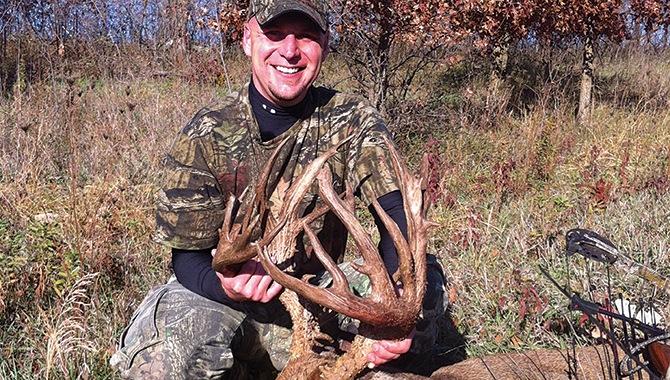 Midway through my third hour in the stand, I decided I had had enough swaying back and forth for one day. It was October 19 in northwest Missouri, and though the conditions weren’t favorable for deer movement—or hunting for that matter—blustery winds and an incoming fall thunderstorm were sure to help mask some mid-season scouting.
Midway through my third hour in the stand, I decided I had had enough swaying back and forth for one day. It was October 19 in northwest Missouri, and though the conditions weren’t favorable for deer movement—or hunting for that matter—blustery winds and an incoming fall thunderstorm were sure to help mask some mid-season scouting.![]()
![]()
![]()
![]()
![]()
![]()
![]()
![]()
![]()
![]()
![]()
![]()
![]()
![]()
![]()
![]()
![]()
![]()
![]()
![]()
![]()
![]()
![]()
![]()
![]()
![]()
![]()
![]()
![]()
![]()
![]()
![]()
![]()
![]()
![]()
![]()
![hightower]() The field sloped towards us a bit, so I knew he would have to hit the high spot to see my decoy. Once he did, he angled right towards her. I had ranged a particular shadow in the field at 40 yards and told my cameraman I would take him at that distance if need be. He stopped momentarily to look at her, and as he started to walk again, he put his head down slightly and I came to full draw.
The field sloped towards us a bit, so I knew he would have to hit the high spot to see my decoy. Once he did, he angled right towards her. I had ranged a particular shadow in the field at 40 yards and told my cameraman I would take him at that distance if need be. He stopped momentarily to look at her, and as he started to walk again, he put his head down slightly and I came to full draw.










































































